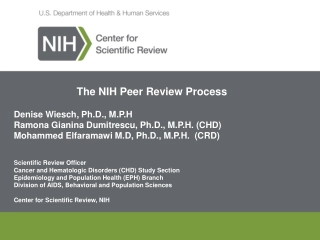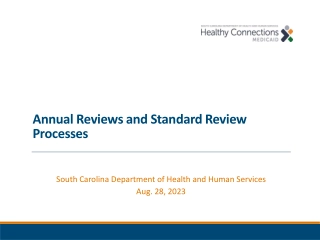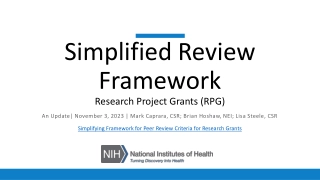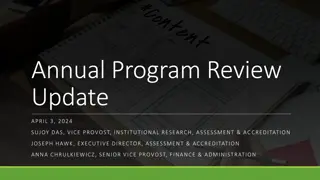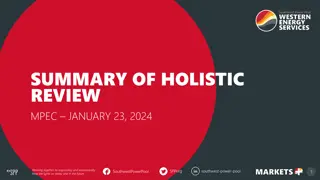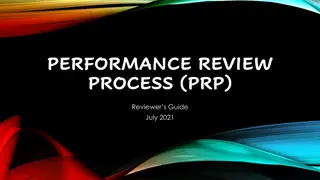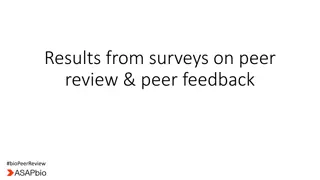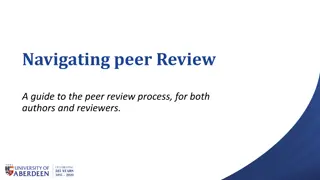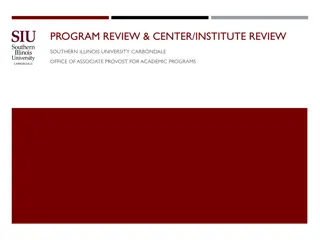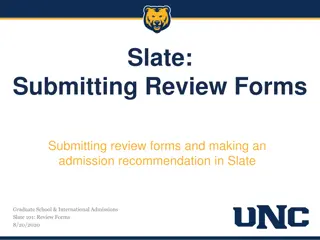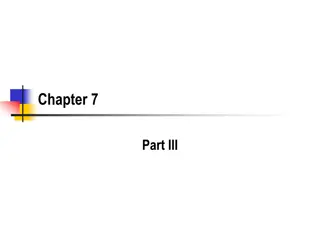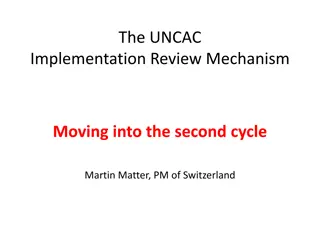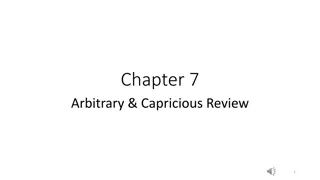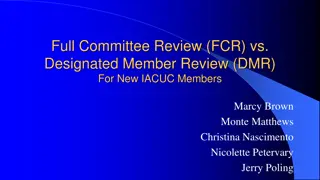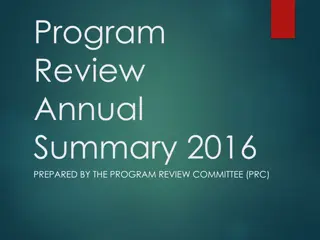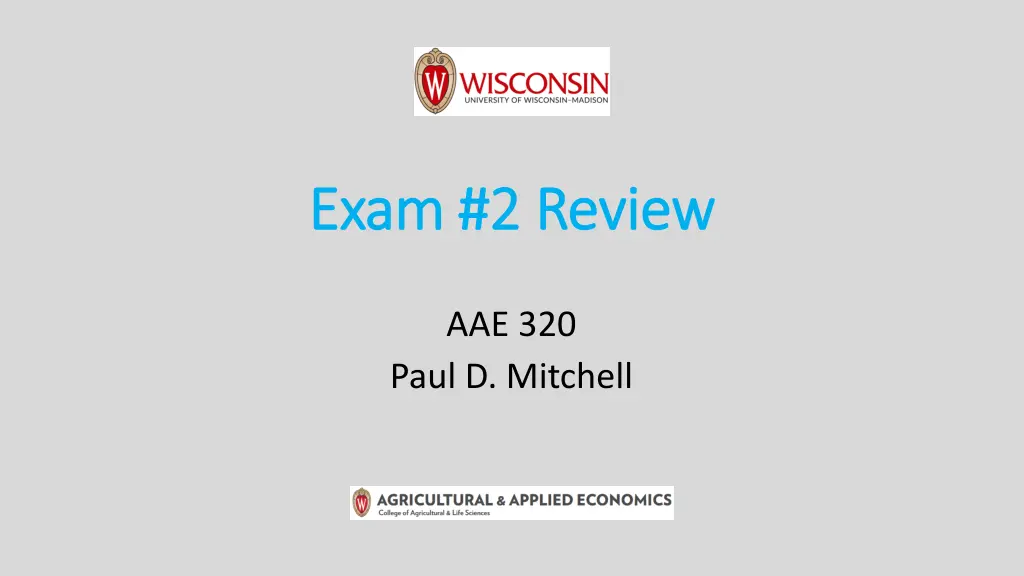
Farm Finance Exam 2 Review & Topics Covered
Prepare for Farm Finance Exam 2 with quantitative and non-quantitative questions on topics like balance sheets, income statements, depreciation, taxes, and more. Understand concepts like asset valuation, depreciation methods, liquidity, solvency, and financial ratios. Get insights into industry data analysis and financial health assessment for the farming sector.
Download Presentation

Please find below an Image/Link to download the presentation.
The content on the website is provided AS IS for your information and personal use only. It may not be sold, licensed, or shared on other websites without obtaining consent from the author. If you encounter any issues during the download, it is possible that the publisher has removed the file from their server.
You are allowed to download the files provided on this website for personal or commercial use, subject to the condition that they are used lawfully. All files are the property of their respective owners.
The content on the website is provided AS IS for your information and personal use only. It may not be sold, licensed, or shared on other websites without obtaining consent from the author.
E N D
Presentation Transcript
Exam #2 Review Exam #2 Review AAE 320 Paul D. Mitchell
Exam #2: Monday November 9, 2020 Available as Word Document 9:00 AM to 11:59 PM on Canvas page as assignment, on Main class page for download and emailed to you Submit answers as Word Document on Canvas by 11:59 PM Add clear scans/photos for potential partial credit for quantitative answers Suppose you type ROROA = 5.7% , but if correct answer is 6.5%, will look at work to see if you earn partial credit: if right method, but made a simple mistake, will get some partial credit
Exam #2 1. Quantitative Questions (math problems to work out) Problem sets: balance sheets, income statements, depreciation, taxes Basically an extended problem set 2. Context questions on Quantitative Questions Give short written answers on terms, interpret results 3. Non-Quantitative Questions Write short paragraph or few sentences, space provided will guide you Expect questions asking for answers that are longer than on older exams: you have more time & access to more information Questions from materials and issues discussed in class Readings, videos, small groups, assignment sheets,
Whats Covered? Major topics since last exam 1) Farm Finance: Balance Sheets, Income Statements 2) Taxes, Business Arrangements and Farm Transfer Posted old Exams #2 over similar topics, plus answers Sometimes material ordered differently
Balance Sheets Basic structure and how to read one Know what current, non-current assets and liabilities are (basic definitions) Be able to give simple examples of each Asset Valuation Market vs Cost basis: be able to explain advantages & weaknesses, why you might want to use each
Depreciation What it is and why do it How to depreciate an asset by the three methods we covered Straight line, Declining balance, Tax table Problems with declining balance and salvage value Tax depreciation a mix of DB and SL Tax depreciation and section 179 depreciation Think Breaks, Problem Sets, Old Exams
Balance Sheets Liquidity and Solvency: Basic definitions, How are they assessed/measured? Know how to calculate and interpret ratios: Current Ratio, Debt to Asset, Equity to Asset and Debt to Equity Ratios Basic idea of what s typical in Midwest crop/livestock farming, why some are low and some are high Interpret aggregate trends in the industry data What they mean for farming sector s financial health
Income Statement Basic structure and how to read one Examples of cash and non-cash revenues and costs Accounts receivable, inventory changes, depreciation recapture vs. depreciation and accounts payable Why farms may want to do accrual adjustments of income statement Move costs/revenues to season when grown How much income did I make in 2019? How much income did in make from my 2019 corn crop?
Income Statement Know how to calculate and interpret Net Farm Income (Accrual Adjusted NFI) (Rate of) Return on Assets (Rate of) Return on Equity Operating Profit Ratio/Profit Margin Think Breaks/class notes, Problem Sets, old Exams for examples Basic idea of what s typical in Midwest crop/livestock farming Interpret aggregate trends in the industry data What they mean for farming sector s financial health
Taxes Focus on the issues that stay the same, not the details that vary Our focus: Income, self-employment, capital gain, gift taxes Basics of how these work and pertain to farmers Revenue, Schedule F costs, depreciation and depreciation recapture, capital gains Tax advantages of section 179 depreciation and cash versus accrual accounting
Taxes and Farm Transfer How to calculate gain: = Sale Price Basis What triggers recognizing gain? Sell/buy or give/receive assets??? Contribute to or remove from Partnership, LLC, Corporation??? Why does Basis change? Death, depreciation, sale, gift??? Gift taxes: what triggers and who pays?
Business Arrangements and Asset Transfers Types of Business Arrangements Sole proprietor, partnership, corporation (C or S), limited liability company (LLC) Main differences among them Establishment: how do you form one? Management: who makes decisions? Taxation: how does it deal with income taxes and does it trigger recognition of gain? Liability: are owners personal assets at risk?
Final Topics Inelasticity in Agriculture Great for true/false or short answer Let s Talk: Dairy Farming in WI Data on typical financial ratios for farms Income tax forms
Exam Preparation Know where to find things we covered in class What s covered where: pre-recorded lectures, recorded live lectures, problem sets, other materials Treat it like a work project: get it done and move on Contact me with questions or problems/crises that arise Cell: 608-320-1162 text or call Email: pdmitchell@wisc.edu

